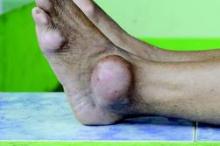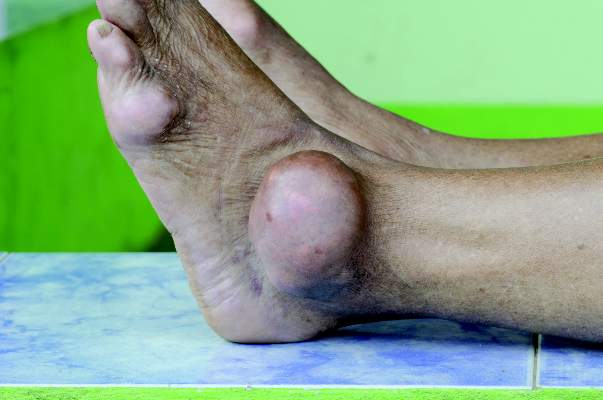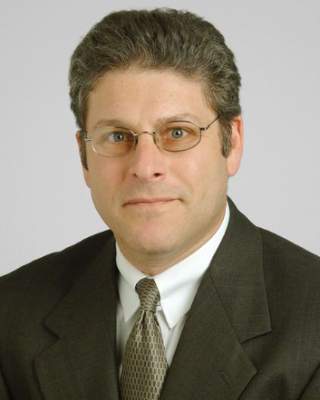User login
Skip vasoreactivity testing in connective tissue disease PAH work-up
LAS VEGAS – It’s okay to skip vasoreactivity testing when working up connective tissue disease patients for suspected pulmonary artery hypertension.
“If you are in a smaller town and your cardiologist doesn’t do vasoreactivity testing, don’t worry about it. You don’t really need it. It’s no longer recommended for patients with scleroderma and connective tissue disease” because they are not vasoreactive, said Dr. Kristin Highland, a pulmonologist and rheumatologist at the Cleveland Clinic.
Right heart catheterization, however, remains the standard for pulmonary artery hypertension (PAH) diagnosis, which requires a mean, resting pulmonary arterial pressure at or above 25 mm Hg with normal pulmonary capillary wedge pressure but increased pulmonary vascular resistance.
Treatment is generally based on functional class, but “I like to look at more data than just the functional class,” Dr. Highland said at the annual Perspectives in Rheumatic Diseases, held by the Global Academy for Medical Education.
Right ventricular heart failure, poor walk tests, and markedly elevated brain natriuretic peptide are among the signs of aggressive disease. Pericardial effusion in the setting of pulmonary hypertension and high right arterial pressure with low cardiac output suggest a dire situation. “If I have any [such findings], I am thinking parenteral and combination therapy;” stand-alone oral therapies are generally for the less sick, she said.
It’s important to rule out pulmonary venous occlusive disease (PVOD) before treating PAH. “These are patients who behave like PAH, but they have pulmonary venule involvement,” as well, and can be thrown into pulmonary edema by specific PAH therapies. Computed tomography can help identify PVOD in scleroderma (Arthritis Rheum. 2012;64[9]:2995-3005). “There are really no good options for these patients except transplant,” Dr. Highland said.
PAH can occur in all connective tissue diseases, but it’s most likely in scleroderma, with a prevalence of about 20%.
Survival improves if disease is caught early, so it’s generally recommended that scleroderma patients be screened by Doppler echocardiography at least yearly. It will capture right-sided hypertrophy, tricuspid regurgitation, pulmonary artery dilation, and other indications that further work-up is warranted.
Although echo is the most useful screening test, there are other noninvasive options. For instance, a decline in the diffusing capacity for carbon monoxide is perhaps one of the earliest signs of pending PAH in scleroderma. Meanwhile, an N-terminal brain natriuretic peptide level of 395 pg/mL has 56% sensitivity and 95% specificity for the presence of PAH. A ratio of forced vital capacity to diffusion capacity above 2 is 71% sensitive and 72% specific (J Rheumatol. 2008;35[3]:458-65).
“Their FVC [forced vital capacity] might be down a little bit, but if their diffusion is way down out of proportion to the FVC, they end up with an elevated ratio. Those patients probably have some pulmonary hypertension along with their interstitial lung disease,” Dr. Highland said.
Dr. Highland is a consultant for Boehringer Ingelheim, an adviser for Bayer Healthcare, and a speaker for Bayer, Actelion, Intermune, Gilead, Genentech, Lung Biotechnology, and United Therapeutics. The Global Academy for Medical Education and this news organization are owned by the same parent company.
LAS VEGAS – It’s okay to skip vasoreactivity testing when working up connective tissue disease patients for suspected pulmonary artery hypertension.
“If you are in a smaller town and your cardiologist doesn’t do vasoreactivity testing, don’t worry about it. You don’t really need it. It’s no longer recommended for patients with scleroderma and connective tissue disease” because they are not vasoreactive, said Dr. Kristin Highland, a pulmonologist and rheumatologist at the Cleveland Clinic.
Right heart catheterization, however, remains the standard for pulmonary artery hypertension (PAH) diagnosis, which requires a mean, resting pulmonary arterial pressure at or above 25 mm Hg with normal pulmonary capillary wedge pressure but increased pulmonary vascular resistance.
Treatment is generally based on functional class, but “I like to look at more data than just the functional class,” Dr. Highland said at the annual Perspectives in Rheumatic Diseases, held by the Global Academy for Medical Education.
Right ventricular heart failure, poor walk tests, and markedly elevated brain natriuretic peptide are among the signs of aggressive disease. Pericardial effusion in the setting of pulmonary hypertension and high right arterial pressure with low cardiac output suggest a dire situation. “If I have any [such findings], I am thinking parenteral and combination therapy;” stand-alone oral therapies are generally for the less sick, she said.
It’s important to rule out pulmonary venous occlusive disease (PVOD) before treating PAH. “These are patients who behave like PAH, but they have pulmonary venule involvement,” as well, and can be thrown into pulmonary edema by specific PAH therapies. Computed tomography can help identify PVOD in scleroderma (Arthritis Rheum. 2012;64[9]:2995-3005). “There are really no good options for these patients except transplant,” Dr. Highland said.
PAH can occur in all connective tissue diseases, but it’s most likely in scleroderma, with a prevalence of about 20%.
Survival improves if disease is caught early, so it’s generally recommended that scleroderma patients be screened by Doppler echocardiography at least yearly. It will capture right-sided hypertrophy, tricuspid regurgitation, pulmonary artery dilation, and other indications that further work-up is warranted.
Although echo is the most useful screening test, there are other noninvasive options. For instance, a decline in the diffusing capacity for carbon monoxide is perhaps one of the earliest signs of pending PAH in scleroderma. Meanwhile, an N-terminal brain natriuretic peptide level of 395 pg/mL has 56% sensitivity and 95% specificity for the presence of PAH. A ratio of forced vital capacity to diffusion capacity above 2 is 71% sensitive and 72% specific (J Rheumatol. 2008;35[3]:458-65).
“Their FVC [forced vital capacity] might be down a little bit, but if their diffusion is way down out of proportion to the FVC, they end up with an elevated ratio. Those patients probably have some pulmonary hypertension along with their interstitial lung disease,” Dr. Highland said.
Dr. Highland is a consultant for Boehringer Ingelheim, an adviser for Bayer Healthcare, and a speaker for Bayer, Actelion, Intermune, Gilead, Genentech, Lung Biotechnology, and United Therapeutics. The Global Academy for Medical Education and this news organization are owned by the same parent company.
LAS VEGAS – It’s okay to skip vasoreactivity testing when working up connective tissue disease patients for suspected pulmonary artery hypertension.
“If you are in a smaller town and your cardiologist doesn’t do vasoreactivity testing, don’t worry about it. You don’t really need it. It’s no longer recommended for patients with scleroderma and connective tissue disease” because they are not vasoreactive, said Dr. Kristin Highland, a pulmonologist and rheumatologist at the Cleveland Clinic.
Right heart catheterization, however, remains the standard for pulmonary artery hypertension (PAH) diagnosis, which requires a mean, resting pulmonary arterial pressure at or above 25 mm Hg with normal pulmonary capillary wedge pressure but increased pulmonary vascular resistance.
Treatment is generally based on functional class, but “I like to look at more data than just the functional class,” Dr. Highland said at the annual Perspectives in Rheumatic Diseases, held by the Global Academy for Medical Education.
Right ventricular heart failure, poor walk tests, and markedly elevated brain natriuretic peptide are among the signs of aggressive disease. Pericardial effusion in the setting of pulmonary hypertension and high right arterial pressure with low cardiac output suggest a dire situation. “If I have any [such findings], I am thinking parenteral and combination therapy;” stand-alone oral therapies are generally for the less sick, she said.
It’s important to rule out pulmonary venous occlusive disease (PVOD) before treating PAH. “These are patients who behave like PAH, but they have pulmonary venule involvement,” as well, and can be thrown into pulmonary edema by specific PAH therapies. Computed tomography can help identify PVOD in scleroderma (Arthritis Rheum. 2012;64[9]:2995-3005). “There are really no good options for these patients except transplant,” Dr. Highland said.
PAH can occur in all connective tissue diseases, but it’s most likely in scleroderma, with a prevalence of about 20%.
Survival improves if disease is caught early, so it’s generally recommended that scleroderma patients be screened by Doppler echocardiography at least yearly. It will capture right-sided hypertrophy, tricuspid regurgitation, pulmonary artery dilation, and other indications that further work-up is warranted.
Although echo is the most useful screening test, there are other noninvasive options. For instance, a decline in the diffusing capacity for carbon monoxide is perhaps one of the earliest signs of pending PAH in scleroderma. Meanwhile, an N-terminal brain natriuretic peptide level of 395 pg/mL has 56% sensitivity and 95% specificity for the presence of PAH. A ratio of forced vital capacity to diffusion capacity above 2 is 71% sensitive and 72% specific (J Rheumatol. 2008;35[3]:458-65).
“Their FVC [forced vital capacity] might be down a little bit, but if their diffusion is way down out of proportion to the FVC, they end up with an elevated ratio. Those patients probably have some pulmonary hypertension along with their interstitial lung disease,” Dr. Highland said.
Dr. Highland is a consultant for Boehringer Ingelheim, an adviser for Bayer Healthcare, and a speaker for Bayer, Actelion, Intermune, Gilead, Genentech, Lung Biotechnology, and United Therapeutics. The Global Academy for Medical Education and this news organization are owned by the same parent company.
FROM THE ANNUAL PERSPECTIVES IN RHEUMATIC DISEASES
Gout treatment lore doesn’t hold up to evidence
LAS VEGAS – It’s okay to start urate lowering therapy during a gout attack, according to Dr. Brian Mandell, a rheumatology professor at the Cleveland Clinic.
“I was taught that you don’t treat a gout attack with urate lowering therapy” because it could trigger a subsequent mobilization attack. “This has been the paradigm for years,” he said at the annual Perspectives in Rheumatic Diseases held by the Global Academy for Medical Education.
But a 2012 study casts doubt on that. In the study, 26 men hospitalized for gout attack were randomized to 300 mg allopurinol daily, while 25 were randomized to placebo. All of the patients were on indomethacin and colchicine. Urate levels dropped rapidly to below 6 mg/dL in the allopurinol group, but there were only two flares. Placebo subjects, meanwhile, had three flares (P= 0.60). There was no significant difference in daily pain scores (Am J Med. 2012 Nov;125(11):1126-1134.e7.).
“The bottom line is the groups did essentially the same. If you are using prophylaxis to treat an acute attack, you are probably perfectly fine to use allopurinol; you don’t need to wait,” Dr. Mandell said. “Does this mean you should start everybody in the hospital on full-dose allopurinol? No, but I think this really broadens our thought processes in terms of handling urate lowering therapy.”
It’s also time to rethink allopurinol dose adjustments in patients with chronic kidney disease (CKD). The thought has been that these patients should be on lower doses to prevent metabolite buildup in the kidneys and hypersensitivity reactions, but “if you follow those guidelines, less than 20% of patients will lower their serum urate, so you will be giving the drug for nothing,” Dr. Mandell said.
“It is true that allopurinol hypersensitivity is more common in patients with CKD,” but it happens in a few per thousand people, and hypersensitivity might have nothing to do with allopurinol dose. “There’s no repeated documentation between the levels and reactions, and in a number of small studies there is no evidence that dose adjustment decreases the frequency of hypersensitivity reactions. We have no data to say this is the right route to take,” he said.
In fact, a study that included 45 CKD patients found that increasing allopurinol beyond creatinine clearance-based dosing doesn’t cause problems. “Toxicity was not increased in patients receiving higher doses of allopurinol, including those with renal impairment,” the authors concluded (Arthritis Rheum. 2011 Feb;63(2):412-21.).
Given the rarity of hypersensitivity reactions, it’s not surprising they didn’t occur in the study’s small group of CKD patients, Dr. Mandell said. “If you are really ultra conservative, you are [still] not going to use allopurinol in CKD,” he said.
But Dr. Mandell said he starts patients on 50 mg of allopurinol. “I educate them about allergic reactions and increase the dose every 1-2 weeks until I hit” a serum uric acid below 6 mg/dL, which often takes more than 300 mg per day. “Alternatively, you can start febuxostat, and if I were to do that I would start at 20 mg” – breaking the lowest dose pill of 40 mg in half – “and then titrate up,” he said.
“It just doesn’t make sense,” Dr. Mandell said, that allopurinol hypersensitivity is related to dose. Instead, there seems to be a genetic predisposition for toxicity in, for instance, Asian patients with the HLA-B*5801 genotype, he noted.
Pegloticase is a bit more problematic than allopurinol. It’s highly effective – patients can drop their serum uric acid from 14 to 0.1 mg/dL within hours – but that comes at the cost of a high mobilization flair rate and infusion reactions in about a quarter of patients, Dr. Mandell said.
There’s a partial workaround. Dr. Mandell said he checks the uric acid level before the second infusion. If it’s not below 6 mg/dL after the first infusion, patients have antibodies against pegloticase. “The drug isn’t going to work, and patients are more likely to get an allergic reaction, so stop the drug,” he said.
Dr. Mandell is a consultant for AstraZeneca and Crealta Pharmaceuticals. The Global Academy for Medical Education and this news organization are owned by the same parent company.
LAS VEGAS – It’s okay to start urate lowering therapy during a gout attack, according to Dr. Brian Mandell, a rheumatology professor at the Cleveland Clinic.
“I was taught that you don’t treat a gout attack with urate lowering therapy” because it could trigger a subsequent mobilization attack. “This has been the paradigm for years,” he said at the annual Perspectives in Rheumatic Diseases held by the Global Academy for Medical Education.
But a 2012 study casts doubt on that. In the study, 26 men hospitalized for gout attack were randomized to 300 mg allopurinol daily, while 25 were randomized to placebo. All of the patients were on indomethacin and colchicine. Urate levels dropped rapidly to below 6 mg/dL in the allopurinol group, but there were only two flares. Placebo subjects, meanwhile, had three flares (P= 0.60). There was no significant difference in daily pain scores (Am J Med. 2012 Nov;125(11):1126-1134.e7.).
“The bottom line is the groups did essentially the same. If you are using prophylaxis to treat an acute attack, you are probably perfectly fine to use allopurinol; you don’t need to wait,” Dr. Mandell said. “Does this mean you should start everybody in the hospital on full-dose allopurinol? No, but I think this really broadens our thought processes in terms of handling urate lowering therapy.”
It’s also time to rethink allopurinol dose adjustments in patients with chronic kidney disease (CKD). The thought has been that these patients should be on lower doses to prevent metabolite buildup in the kidneys and hypersensitivity reactions, but “if you follow those guidelines, less than 20% of patients will lower their serum urate, so you will be giving the drug for nothing,” Dr. Mandell said.
“It is true that allopurinol hypersensitivity is more common in patients with CKD,” but it happens in a few per thousand people, and hypersensitivity might have nothing to do with allopurinol dose. “There’s no repeated documentation between the levels and reactions, and in a number of small studies there is no evidence that dose adjustment decreases the frequency of hypersensitivity reactions. We have no data to say this is the right route to take,” he said.
In fact, a study that included 45 CKD patients found that increasing allopurinol beyond creatinine clearance-based dosing doesn’t cause problems. “Toxicity was not increased in patients receiving higher doses of allopurinol, including those with renal impairment,” the authors concluded (Arthritis Rheum. 2011 Feb;63(2):412-21.).
Given the rarity of hypersensitivity reactions, it’s not surprising they didn’t occur in the study’s small group of CKD patients, Dr. Mandell said. “If you are really ultra conservative, you are [still] not going to use allopurinol in CKD,” he said.
But Dr. Mandell said he starts patients on 50 mg of allopurinol. “I educate them about allergic reactions and increase the dose every 1-2 weeks until I hit” a serum uric acid below 6 mg/dL, which often takes more than 300 mg per day. “Alternatively, you can start febuxostat, and if I were to do that I would start at 20 mg” – breaking the lowest dose pill of 40 mg in half – “and then titrate up,” he said.
“It just doesn’t make sense,” Dr. Mandell said, that allopurinol hypersensitivity is related to dose. Instead, there seems to be a genetic predisposition for toxicity in, for instance, Asian patients with the HLA-B*5801 genotype, he noted.
Pegloticase is a bit more problematic than allopurinol. It’s highly effective – patients can drop their serum uric acid from 14 to 0.1 mg/dL within hours – but that comes at the cost of a high mobilization flair rate and infusion reactions in about a quarter of patients, Dr. Mandell said.
There’s a partial workaround. Dr. Mandell said he checks the uric acid level before the second infusion. If it’s not below 6 mg/dL after the first infusion, patients have antibodies against pegloticase. “The drug isn’t going to work, and patients are more likely to get an allergic reaction, so stop the drug,” he said.
Dr. Mandell is a consultant for AstraZeneca and Crealta Pharmaceuticals. The Global Academy for Medical Education and this news organization are owned by the same parent company.
LAS VEGAS – It’s okay to start urate lowering therapy during a gout attack, according to Dr. Brian Mandell, a rheumatology professor at the Cleveland Clinic.
“I was taught that you don’t treat a gout attack with urate lowering therapy” because it could trigger a subsequent mobilization attack. “This has been the paradigm for years,” he said at the annual Perspectives in Rheumatic Diseases held by the Global Academy for Medical Education.
But a 2012 study casts doubt on that. In the study, 26 men hospitalized for gout attack were randomized to 300 mg allopurinol daily, while 25 were randomized to placebo. All of the patients were on indomethacin and colchicine. Urate levels dropped rapidly to below 6 mg/dL in the allopurinol group, but there were only two flares. Placebo subjects, meanwhile, had three flares (P= 0.60). There was no significant difference in daily pain scores (Am J Med. 2012 Nov;125(11):1126-1134.e7.).
“The bottom line is the groups did essentially the same. If you are using prophylaxis to treat an acute attack, you are probably perfectly fine to use allopurinol; you don’t need to wait,” Dr. Mandell said. “Does this mean you should start everybody in the hospital on full-dose allopurinol? No, but I think this really broadens our thought processes in terms of handling urate lowering therapy.”
It’s also time to rethink allopurinol dose adjustments in patients with chronic kidney disease (CKD). The thought has been that these patients should be on lower doses to prevent metabolite buildup in the kidneys and hypersensitivity reactions, but “if you follow those guidelines, less than 20% of patients will lower their serum urate, so you will be giving the drug for nothing,” Dr. Mandell said.
“It is true that allopurinol hypersensitivity is more common in patients with CKD,” but it happens in a few per thousand people, and hypersensitivity might have nothing to do with allopurinol dose. “There’s no repeated documentation between the levels and reactions, and in a number of small studies there is no evidence that dose adjustment decreases the frequency of hypersensitivity reactions. We have no data to say this is the right route to take,” he said.
In fact, a study that included 45 CKD patients found that increasing allopurinol beyond creatinine clearance-based dosing doesn’t cause problems. “Toxicity was not increased in patients receiving higher doses of allopurinol, including those with renal impairment,” the authors concluded (Arthritis Rheum. 2011 Feb;63(2):412-21.).
Given the rarity of hypersensitivity reactions, it’s not surprising they didn’t occur in the study’s small group of CKD patients, Dr. Mandell said. “If you are really ultra conservative, you are [still] not going to use allopurinol in CKD,” he said.
But Dr. Mandell said he starts patients on 50 mg of allopurinol. “I educate them about allergic reactions and increase the dose every 1-2 weeks until I hit” a serum uric acid below 6 mg/dL, which often takes more than 300 mg per day. “Alternatively, you can start febuxostat, and if I were to do that I would start at 20 mg” – breaking the lowest dose pill of 40 mg in half – “and then titrate up,” he said.
“It just doesn’t make sense,” Dr. Mandell said, that allopurinol hypersensitivity is related to dose. Instead, there seems to be a genetic predisposition for toxicity in, for instance, Asian patients with the HLA-B*5801 genotype, he noted.
Pegloticase is a bit more problematic than allopurinol. It’s highly effective – patients can drop their serum uric acid from 14 to 0.1 mg/dL within hours – but that comes at the cost of a high mobilization flair rate and infusion reactions in about a quarter of patients, Dr. Mandell said.
There’s a partial workaround. Dr. Mandell said he checks the uric acid level before the second infusion. If it’s not below 6 mg/dL after the first infusion, patients have antibodies against pegloticase. “The drug isn’t going to work, and patients are more likely to get an allergic reaction, so stop the drug,” he said.
Dr. Mandell is a consultant for AstraZeneca and Crealta Pharmaceuticals. The Global Academy for Medical Education and this news organization are owned by the same parent company.
EXPERT ANALYSIS FROM PERSPECTIVES IN RHEUMATIC DISEASES
VIDEO: Fibromyalgia doesn’t fit the disease model
LAS VEGAS – There’s no easy fix for fibromyalgia, a problem that seems to lurk in the gap between mind and body.
Pharmaceuticals don’t work too well, and patients usually stop taking them after a while. Physicians are often at a loss for what to try next.
Part of the problem, at least for now, is that fibromyalgia is a poor fit for the medical model; it may be time to reconsider it from a broader perspective, according to Dr. Brian Walitt, director of clinical pain research at the National Center for Complementary and Integrative Health, in Bethesda, Md. He shared his insights – and a few tips for helping sufferers – in a video interview at the annual Perspectives in Rheumatic Diseases, held by Global Academy for Medical Education.
Global Academy for Medical Education and this news organization are owned by the same parent company.
The video associated with this article is no longer available on this site. Please view all of our videos on the MDedge YouTube channel
LAS VEGAS – There’s no easy fix for fibromyalgia, a problem that seems to lurk in the gap between mind and body.
Pharmaceuticals don’t work too well, and patients usually stop taking them after a while. Physicians are often at a loss for what to try next.
Part of the problem, at least for now, is that fibromyalgia is a poor fit for the medical model; it may be time to reconsider it from a broader perspective, according to Dr. Brian Walitt, director of clinical pain research at the National Center for Complementary and Integrative Health, in Bethesda, Md. He shared his insights – and a few tips for helping sufferers – in a video interview at the annual Perspectives in Rheumatic Diseases, held by Global Academy for Medical Education.
Global Academy for Medical Education and this news organization are owned by the same parent company.
The video associated with this article is no longer available on this site. Please view all of our videos on the MDedge YouTube channel
LAS VEGAS – There’s no easy fix for fibromyalgia, a problem that seems to lurk in the gap between mind and body.
Pharmaceuticals don’t work too well, and patients usually stop taking them after a while. Physicians are often at a loss for what to try next.
Part of the problem, at least for now, is that fibromyalgia is a poor fit for the medical model; it may be time to reconsider it from a broader perspective, according to Dr. Brian Walitt, director of clinical pain research at the National Center for Complementary and Integrative Health, in Bethesda, Md. He shared his insights – and a few tips for helping sufferers – in a video interview at the annual Perspectives in Rheumatic Diseases, held by Global Academy for Medical Education.
Global Academy for Medical Education and this news organization are owned by the same parent company.
The video associated with this article is no longer available on this site. Please view all of our videos on the MDedge YouTube channel
EXPERT ANALYSIS FROM THE ANNUAL PERSPECTIVES IN RHEUMATIC DISEASES
VIDEO: How to handle pregnancy in lupus
LAS VEGAS – Pregnancy outcomes can be excellent in women with lupus, but they need help to make sure everything goes okay.
Rheumatologist Dr. Jennifer Grossman, director of lupus clinical investigational research at the University of California, Los Angeles, knows how to do it right. In a video interview at the annual Perspectives in Rheumatic Diseases held by Global Academy for Medical Education, she discussed tips on managing pregnancy in lupus patients, including the use of hydroxychloroquine to prevent flares, azathioprine to treat lupus nephritis, and aspirin to reduce the risk of preeclampsia.
Global Academy for Medical Education and this news organization are owned by the same parent company.
The video associated with this article is no longer available on this site. Please view all of our videos on the MDedge YouTube channel
LAS VEGAS – Pregnancy outcomes can be excellent in women with lupus, but they need help to make sure everything goes okay.
Rheumatologist Dr. Jennifer Grossman, director of lupus clinical investigational research at the University of California, Los Angeles, knows how to do it right. In a video interview at the annual Perspectives in Rheumatic Diseases held by Global Academy for Medical Education, she discussed tips on managing pregnancy in lupus patients, including the use of hydroxychloroquine to prevent flares, azathioprine to treat lupus nephritis, and aspirin to reduce the risk of preeclampsia.
Global Academy for Medical Education and this news organization are owned by the same parent company.
The video associated with this article is no longer available on this site. Please view all of our videos on the MDedge YouTube channel
LAS VEGAS – Pregnancy outcomes can be excellent in women with lupus, but they need help to make sure everything goes okay.
Rheumatologist Dr. Jennifer Grossman, director of lupus clinical investigational research at the University of California, Los Angeles, knows how to do it right. In a video interview at the annual Perspectives in Rheumatic Diseases held by Global Academy for Medical Education, she discussed tips on managing pregnancy in lupus patients, including the use of hydroxychloroquine to prevent flares, azathioprine to treat lupus nephritis, and aspirin to reduce the risk of preeclampsia.
Global Academy for Medical Education and this news organization are owned by the same parent company.
The video associated with this article is no longer available on this site. Please view all of our videos on the MDedge YouTube channel
EXPERT ANALYSIS FROM THE ANNUAL PERSPECTIVES IN RHEUMATIC DISEASES
VIDEO: Simple skin finding differentiates diffuse scleroderma from limited disease
LAS VEGAS – Scleroderma treatment is evolving quickly.
Newer classification criteria from the American College of Rheumatology and the European League Against Rheumatism are helping diagnose and treat the disease earlier, and ongoing investigations are defining the proper roles of mycophenolate mofetil, cyclophosphamide, stem cell transplants, and other treatments in the disease. Meanwhile, the Food and Drug Administration has granted Breakthrough Therapy Designation status to tocilizumab for its development as a potential treatment for scleroderma.
In an interview at the annual Perspectives in Rheumatic Diseases held by Global Academy for Medical Education, Dr. Daniel Furst, the Carl M. Pearson Professor in Rheumatology at the University of California, Los Angeles, gave a quick review of those and other recent developments and shared a few treatment pearls, including how he uses a simple skin finding to differentiate diffuse from limited disease.
Global Academy for Medical Education and this news organization are owned by the same parent company.
The video associated with this article is no longer available on this site. Please view all of our videos on the MDedge YouTube channel
LAS VEGAS – Scleroderma treatment is evolving quickly.
Newer classification criteria from the American College of Rheumatology and the European League Against Rheumatism are helping diagnose and treat the disease earlier, and ongoing investigations are defining the proper roles of mycophenolate mofetil, cyclophosphamide, stem cell transplants, and other treatments in the disease. Meanwhile, the Food and Drug Administration has granted Breakthrough Therapy Designation status to tocilizumab for its development as a potential treatment for scleroderma.
In an interview at the annual Perspectives in Rheumatic Diseases held by Global Academy for Medical Education, Dr. Daniel Furst, the Carl M. Pearson Professor in Rheumatology at the University of California, Los Angeles, gave a quick review of those and other recent developments and shared a few treatment pearls, including how he uses a simple skin finding to differentiate diffuse from limited disease.
Global Academy for Medical Education and this news organization are owned by the same parent company.
The video associated with this article is no longer available on this site. Please view all of our videos on the MDedge YouTube channel
LAS VEGAS – Scleroderma treatment is evolving quickly.
Newer classification criteria from the American College of Rheumatology and the European League Against Rheumatism are helping diagnose and treat the disease earlier, and ongoing investigations are defining the proper roles of mycophenolate mofetil, cyclophosphamide, stem cell transplants, and other treatments in the disease. Meanwhile, the Food and Drug Administration has granted Breakthrough Therapy Designation status to tocilizumab for its development as a potential treatment for scleroderma.
In an interview at the annual Perspectives in Rheumatic Diseases held by Global Academy for Medical Education, Dr. Daniel Furst, the Carl M. Pearson Professor in Rheumatology at the University of California, Los Angeles, gave a quick review of those and other recent developments and shared a few treatment pearls, including how he uses a simple skin finding to differentiate diffuse from limited disease.
Global Academy for Medical Education and this news organization are owned by the same parent company.
The video associated with this article is no longer available on this site. Please view all of our videos on the MDedge YouTube channel
EXPERT ANALYSIS FROM THE ANNUAL PERSPECTIVES IN RHEUMATIC DISEASES
Aspirin, hydrochlorothiazide okay in gout
It’s okay in most cases for gout patients to be on thiazide diuretics or low-dose aspirin, so long as hypouricemic therapy is adjusted as needed, according to rheumatologist and Cleveland Clinic professor Dr. Brian F. Mandell.
Coronary artery disease is common in gout, so patients benefit from inexpensive, well-tolerated, and effective treatments like thiazides for hypertension and 81 mg aspirin daily for cardioprotection, Dr. Mandell said at the annual Perspectives in Rheumatic Diseases conference held by Global Academy for Medical Education.
The concern, however, is that both can elevate serum uric acid. Observational and survey data suggest that the drugs may be associated with an increase in attacks, so some shy away from them in gout.
To make sense of the issue, the first thing to remember is that the drugs cause only “minimal elevations in serum uric acid. Serum urate can still be lowered to less than 6 mg/dL with appropriate therapy without stopping them,” Dr. Mandell said.
Low-dose aspirin raises serum urate by about 0.3 mg/dL. At 12.5 or 25 mg once a day – common hypertension doses – hydrochlorothiazide increases serum urate by 0.8 mg/dL or less in patients with normal renal function (Arthritis Rheum. 2012 Jan;64[1]:121-9).
“In patients with chronic gout treated with a xanthine oxidase inhibitor (allopurinol or febuxostat) to lower the serum urate” to recommended target levels below 6.0 mg/dL, “the small elevation in serum urate is unlikely to negate the clinical efficacy of these drugs when dosing is optimized,” Dr. Mandell wrote in an article that expands upon his presentation points (Cleve Clin J Med. 2014 Feb;81[2]:83-6).
Based on those considerations, “my practice in most patients is to use a thiazide if it helps to control the blood pressure and to adjust the dose of the hypouricemic therapy as needed to reduce the serum urate to the desired level. ... Continuing thiazide therapy and, if necessary, adjusting hypouricemic therapy will not worsen the control of the serum urate level or gouty arthritis, and in most patients will not complicate the management of gout.” In general, “when I add a thiazide to a patient’s regimen, I do not usually need to increase the dose of allopurinol significantly to keep the serum urate level below the desired target,” he said.
The approach is similar with low-dose aspirin. Because of its negligible effect on serum uric acid levels, it does not need to be stopped in hyperuricemia or gout. “Since patients with gout have a higher risk of having cardiovascular disease, metabolic syndrome, and chronic kidney disease, many will benefit from low-dose aspirin therapy,” he said.
Occasionally, it makes sense to switch from a thiazide to another hypertensive, such as losartan, in chronic, hypertensive gout patients with serum urate levels marginally above the precipitation threshold of 6.7 mg/dL. “Losartan is a weak uricosuric and can lower the serum urate level slightly, possibly making the addition of another hypouricemic agent unnecessary, while still controlling the blood pressure with a single pill,” Dr. Mandell said.
The decision “must be individualized, taking into consideration the efficacy and cost of the alternative antihypertensive drug, as well as the potential but as yet unproven cardiovascular and renal benefits of lowering the serum urate with a more potent hypouricemic to a degree not likely to be attained with losartan alone,” he said.
Dr. Mandell has been a consultant for Savient/Crealta, AstraZeneca, Regeneron, and Novartis. Global Academy for Medical Education and this news organization are owned by the same parent company.
It’s okay in most cases for gout patients to be on thiazide diuretics or low-dose aspirin, so long as hypouricemic therapy is adjusted as needed, according to rheumatologist and Cleveland Clinic professor Dr. Brian F. Mandell.
Coronary artery disease is common in gout, so patients benefit from inexpensive, well-tolerated, and effective treatments like thiazides for hypertension and 81 mg aspirin daily for cardioprotection, Dr. Mandell said at the annual Perspectives in Rheumatic Diseases conference held by Global Academy for Medical Education.
The concern, however, is that both can elevate serum uric acid. Observational and survey data suggest that the drugs may be associated with an increase in attacks, so some shy away from them in gout.
To make sense of the issue, the first thing to remember is that the drugs cause only “minimal elevations in serum uric acid. Serum urate can still be lowered to less than 6 mg/dL with appropriate therapy without stopping them,” Dr. Mandell said.
Low-dose aspirin raises serum urate by about 0.3 mg/dL. At 12.5 or 25 mg once a day – common hypertension doses – hydrochlorothiazide increases serum urate by 0.8 mg/dL or less in patients with normal renal function (Arthritis Rheum. 2012 Jan;64[1]:121-9).
“In patients with chronic gout treated with a xanthine oxidase inhibitor (allopurinol or febuxostat) to lower the serum urate” to recommended target levels below 6.0 mg/dL, “the small elevation in serum urate is unlikely to negate the clinical efficacy of these drugs when dosing is optimized,” Dr. Mandell wrote in an article that expands upon his presentation points (Cleve Clin J Med. 2014 Feb;81[2]:83-6).
Based on those considerations, “my practice in most patients is to use a thiazide if it helps to control the blood pressure and to adjust the dose of the hypouricemic therapy as needed to reduce the serum urate to the desired level. ... Continuing thiazide therapy and, if necessary, adjusting hypouricemic therapy will not worsen the control of the serum urate level or gouty arthritis, and in most patients will not complicate the management of gout.” In general, “when I add a thiazide to a patient’s regimen, I do not usually need to increase the dose of allopurinol significantly to keep the serum urate level below the desired target,” he said.
The approach is similar with low-dose aspirin. Because of its negligible effect on serum uric acid levels, it does not need to be stopped in hyperuricemia or gout. “Since patients with gout have a higher risk of having cardiovascular disease, metabolic syndrome, and chronic kidney disease, many will benefit from low-dose aspirin therapy,” he said.
Occasionally, it makes sense to switch from a thiazide to another hypertensive, such as losartan, in chronic, hypertensive gout patients with serum urate levels marginally above the precipitation threshold of 6.7 mg/dL. “Losartan is a weak uricosuric and can lower the serum urate level slightly, possibly making the addition of another hypouricemic agent unnecessary, while still controlling the blood pressure with a single pill,” Dr. Mandell said.
The decision “must be individualized, taking into consideration the efficacy and cost of the alternative antihypertensive drug, as well as the potential but as yet unproven cardiovascular and renal benefits of lowering the serum urate with a more potent hypouricemic to a degree not likely to be attained with losartan alone,” he said.
Dr. Mandell has been a consultant for Savient/Crealta, AstraZeneca, Regeneron, and Novartis. Global Academy for Medical Education and this news organization are owned by the same parent company.
It’s okay in most cases for gout patients to be on thiazide diuretics or low-dose aspirin, so long as hypouricemic therapy is adjusted as needed, according to rheumatologist and Cleveland Clinic professor Dr. Brian F. Mandell.
Coronary artery disease is common in gout, so patients benefit from inexpensive, well-tolerated, and effective treatments like thiazides for hypertension and 81 mg aspirin daily for cardioprotection, Dr. Mandell said at the annual Perspectives in Rheumatic Diseases conference held by Global Academy for Medical Education.
The concern, however, is that both can elevate serum uric acid. Observational and survey data suggest that the drugs may be associated with an increase in attacks, so some shy away from them in gout.
To make sense of the issue, the first thing to remember is that the drugs cause only “minimal elevations in serum uric acid. Serum urate can still be lowered to less than 6 mg/dL with appropriate therapy without stopping them,” Dr. Mandell said.
Low-dose aspirin raises serum urate by about 0.3 mg/dL. At 12.5 or 25 mg once a day – common hypertension doses – hydrochlorothiazide increases serum urate by 0.8 mg/dL or less in patients with normal renal function (Arthritis Rheum. 2012 Jan;64[1]:121-9).
“In patients with chronic gout treated with a xanthine oxidase inhibitor (allopurinol or febuxostat) to lower the serum urate” to recommended target levels below 6.0 mg/dL, “the small elevation in serum urate is unlikely to negate the clinical efficacy of these drugs when dosing is optimized,” Dr. Mandell wrote in an article that expands upon his presentation points (Cleve Clin J Med. 2014 Feb;81[2]:83-6).
Based on those considerations, “my practice in most patients is to use a thiazide if it helps to control the blood pressure and to adjust the dose of the hypouricemic therapy as needed to reduce the serum urate to the desired level. ... Continuing thiazide therapy and, if necessary, adjusting hypouricemic therapy will not worsen the control of the serum urate level or gouty arthritis, and in most patients will not complicate the management of gout.” In general, “when I add a thiazide to a patient’s regimen, I do not usually need to increase the dose of allopurinol significantly to keep the serum urate level below the desired target,” he said.
The approach is similar with low-dose aspirin. Because of its negligible effect on serum uric acid levels, it does not need to be stopped in hyperuricemia or gout. “Since patients with gout have a higher risk of having cardiovascular disease, metabolic syndrome, and chronic kidney disease, many will benefit from low-dose aspirin therapy,” he said.
Occasionally, it makes sense to switch from a thiazide to another hypertensive, such as losartan, in chronic, hypertensive gout patients with serum urate levels marginally above the precipitation threshold of 6.7 mg/dL. “Losartan is a weak uricosuric and can lower the serum urate level slightly, possibly making the addition of another hypouricemic agent unnecessary, while still controlling the blood pressure with a single pill,” Dr. Mandell said.
The decision “must be individualized, taking into consideration the efficacy and cost of the alternative antihypertensive drug, as well as the potential but as yet unproven cardiovascular and renal benefits of lowering the serum urate with a more potent hypouricemic to a degree not likely to be attained with losartan alone,” he said.
Dr. Mandell has been a consultant for Savient/Crealta, AstraZeneca, Regeneron, and Novartis. Global Academy for Medical Education and this news organization are owned by the same parent company.
EXPERT ANALYSIS FROM THE ANNUAL PERSPECTIVES IN RHEUMATIC DISEASES
Tissue-based treatment could improve psoriatic arthritis outcomes
Efforts underway to tailor psoriatic arthritis treatments to the various tissues involved in the pathogenesis of the disease could optimize therapeutic approaches, Dr. Iain McInnes said at the annual Perspectives in Rheumatic Diseases held by Global Academy for Medical Education.
“Psoriatic arthritis [PsA] is a disease whose treatment is evolving quickly, ” added Dr. McInnes, professor of medicine and director of the Institute of Infection, Immunity, and Inflammation at the University of Glasgow (Scotland). “We have new ideas about pathogenesis, emerging studies that inform the best strategic approach to disease management, including potential value in a treat-to-target approach, and new therapeutics that offer a range of options to allow us to optimize treatment.”
He pointed to recent evidence for a diverse pathogenesis of PsA subtypes. Synovial membranes in PsA have high levels of tumor necrosis factor (TNF)-alpha, while resident populations of interleukin (IL)-23 receptor–positive T cells are found in entheses and IL-17 is abundant in psoriatic lesions. Genome-wide association studies have underscored the role of the IL-23 and IL-17 cytokine axis, while other work has implicated Th17 cytokines in mesenchymal tissue changes.
Although drug development efforts have typically viewed rheumatoid arthritis and PsA as homogeneous, “we can appreciate the extent of articular, entheseal, and cutaneous involvement, and look to tailor therapies accordingly,” Dr. McInnes said.
So what will the next decade look like for PsA? Therapy will center around TNF-alpha inhibitors, new cytokine pathways, and small-molecule inhibitors, according to Dr. McInnes. While anti-TNF agents are not universally tolerated or effective, their “well-established safety profile” and positive effects on American College of Rheumatology response criteria and radiographic endpoints generally outweigh risks of infection and problems with decreasing long-term drug survival, he said. These agents also can improve disease activity, skin symptoms, physical function, fatigue, overall quality of life, enthesitis, and dactylitis, he noted.
Other recent additions to the PsA arsenal include the IL-12/IL-23 inhibitor ustekinumab (Stelara), which in the PSUMMIT 1 and 2 trials was associated with decreased rates of radiographic progression and dose-dependent improvements in enthesitis, Dr. McInnes said. The phosphodiesterase-4 inhibitor apremilast (Otezla) was associated with significantly better ACR 20 response at week 16 and significantly greater improvements in Maastricht Ankylosing Spondylitis Enthesis Score and measures of dactylitis at week 24 of the PALACE trials. Most recently, in the FUTURE1 and FUTURE2 trials, the IL-17A inhibitor secukinumab (Cosentyx) beat placebo in terms of ACR 20, ACR 50, ACR 70, resolution of dactylitis and enthesitis, and radiographic measures of disease progression.
The availability of effective biologics raises the possibility of a treat-to-target approach geared toward clinical remission or low disease activity, Dr. McInnes concluded. “Targets for low disease activity in PsA are now available. Composite measures of disease activity, such as minimal disease activity (MDA), encompass all clinically important aspects of PsA,” he emphasized. While studies still need to pinpoint the best therapeutic pathways for disease subtypes, the first treat-to-target study of PsA found that tailoring therapy based on remission or minimal disease activity led to significantly better ACR 20, ACR 50, and ACR 70 responses at week 48, compared with standard care, he noted.
Dr. McInnes reported receiving research funding or honoraria from Novartis, Janssen, AbbVie, UCB, Pfizer, and MSD Pharmaceuticals, all of which make medications for rheumatic diseases. Global Academy for Medical Education and this news organization are owned by the same parent company.
Efforts underway to tailor psoriatic arthritis treatments to the various tissues involved in the pathogenesis of the disease could optimize therapeutic approaches, Dr. Iain McInnes said at the annual Perspectives in Rheumatic Diseases held by Global Academy for Medical Education.
“Psoriatic arthritis [PsA] is a disease whose treatment is evolving quickly, ” added Dr. McInnes, professor of medicine and director of the Institute of Infection, Immunity, and Inflammation at the University of Glasgow (Scotland). “We have new ideas about pathogenesis, emerging studies that inform the best strategic approach to disease management, including potential value in a treat-to-target approach, and new therapeutics that offer a range of options to allow us to optimize treatment.”
He pointed to recent evidence for a diverse pathogenesis of PsA subtypes. Synovial membranes in PsA have high levels of tumor necrosis factor (TNF)-alpha, while resident populations of interleukin (IL)-23 receptor–positive T cells are found in entheses and IL-17 is abundant in psoriatic lesions. Genome-wide association studies have underscored the role of the IL-23 and IL-17 cytokine axis, while other work has implicated Th17 cytokines in mesenchymal tissue changes.
Although drug development efforts have typically viewed rheumatoid arthritis and PsA as homogeneous, “we can appreciate the extent of articular, entheseal, and cutaneous involvement, and look to tailor therapies accordingly,” Dr. McInnes said.
So what will the next decade look like for PsA? Therapy will center around TNF-alpha inhibitors, new cytokine pathways, and small-molecule inhibitors, according to Dr. McInnes. While anti-TNF agents are not universally tolerated or effective, their “well-established safety profile” and positive effects on American College of Rheumatology response criteria and radiographic endpoints generally outweigh risks of infection and problems with decreasing long-term drug survival, he said. These agents also can improve disease activity, skin symptoms, physical function, fatigue, overall quality of life, enthesitis, and dactylitis, he noted.
Other recent additions to the PsA arsenal include the IL-12/IL-23 inhibitor ustekinumab (Stelara), which in the PSUMMIT 1 and 2 trials was associated with decreased rates of radiographic progression and dose-dependent improvements in enthesitis, Dr. McInnes said. The phosphodiesterase-4 inhibitor apremilast (Otezla) was associated with significantly better ACR 20 response at week 16 and significantly greater improvements in Maastricht Ankylosing Spondylitis Enthesis Score and measures of dactylitis at week 24 of the PALACE trials. Most recently, in the FUTURE1 and FUTURE2 trials, the IL-17A inhibitor secukinumab (Cosentyx) beat placebo in terms of ACR 20, ACR 50, ACR 70, resolution of dactylitis and enthesitis, and radiographic measures of disease progression.
The availability of effective biologics raises the possibility of a treat-to-target approach geared toward clinical remission or low disease activity, Dr. McInnes concluded. “Targets for low disease activity in PsA are now available. Composite measures of disease activity, such as minimal disease activity (MDA), encompass all clinically important aspects of PsA,” he emphasized. While studies still need to pinpoint the best therapeutic pathways for disease subtypes, the first treat-to-target study of PsA found that tailoring therapy based on remission or minimal disease activity led to significantly better ACR 20, ACR 50, and ACR 70 responses at week 48, compared with standard care, he noted.
Dr. McInnes reported receiving research funding or honoraria from Novartis, Janssen, AbbVie, UCB, Pfizer, and MSD Pharmaceuticals, all of which make medications for rheumatic diseases. Global Academy for Medical Education and this news organization are owned by the same parent company.
Efforts underway to tailor psoriatic arthritis treatments to the various tissues involved in the pathogenesis of the disease could optimize therapeutic approaches, Dr. Iain McInnes said at the annual Perspectives in Rheumatic Diseases held by Global Academy for Medical Education.
“Psoriatic arthritis [PsA] is a disease whose treatment is evolving quickly, ” added Dr. McInnes, professor of medicine and director of the Institute of Infection, Immunity, and Inflammation at the University of Glasgow (Scotland). “We have new ideas about pathogenesis, emerging studies that inform the best strategic approach to disease management, including potential value in a treat-to-target approach, and new therapeutics that offer a range of options to allow us to optimize treatment.”
He pointed to recent evidence for a diverse pathogenesis of PsA subtypes. Synovial membranes in PsA have high levels of tumor necrosis factor (TNF)-alpha, while resident populations of interleukin (IL)-23 receptor–positive T cells are found in entheses and IL-17 is abundant in psoriatic lesions. Genome-wide association studies have underscored the role of the IL-23 and IL-17 cytokine axis, while other work has implicated Th17 cytokines in mesenchymal tissue changes.
Although drug development efforts have typically viewed rheumatoid arthritis and PsA as homogeneous, “we can appreciate the extent of articular, entheseal, and cutaneous involvement, and look to tailor therapies accordingly,” Dr. McInnes said.
So what will the next decade look like for PsA? Therapy will center around TNF-alpha inhibitors, new cytokine pathways, and small-molecule inhibitors, according to Dr. McInnes. While anti-TNF agents are not universally tolerated or effective, their “well-established safety profile” and positive effects on American College of Rheumatology response criteria and radiographic endpoints generally outweigh risks of infection and problems with decreasing long-term drug survival, he said. These agents also can improve disease activity, skin symptoms, physical function, fatigue, overall quality of life, enthesitis, and dactylitis, he noted.
Other recent additions to the PsA arsenal include the IL-12/IL-23 inhibitor ustekinumab (Stelara), which in the PSUMMIT 1 and 2 trials was associated with decreased rates of radiographic progression and dose-dependent improvements in enthesitis, Dr. McInnes said. The phosphodiesterase-4 inhibitor apremilast (Otezla) was associated with significantly better ACR 20 response at week 16 and significantly greater improvements in Maastricht Ankylosing Spondylitis Enthesis Score and measures of dactylitis at week 24 of the PALACE trials. Most recently, in the FUTURE1 and FUTURE2 trials, the IL-17A inhibitor secukinumab (Cosentyx) beat placebo in terms of ACR 20, ACR 50, ACR 70, resolution of dactylitis and enthesitis, and radiographic measures of disease progression.
The availability of effective biologics raises the possibility of a treat-to-target approach geared toward clinical remission or low disease activity, Dr. McInnes concluded. “Targets for low disease activity in PsA are now available. Composite measures of disease activity, such as minimal disease activity (MDA), encompass all clinically important aspects of PsA,” he emphasized. While studies still need to pinpoint the best therapeutic pathways for disease subtypes, the first treat-to-target study of PsA found that tailoring therapy based on remission or minimal disease activity led to significantly better ACR 20, ACR 50, and ACR 70 responses at week 48, compared with standard care, he noted.
Dr. McInnes reported receiving research funding or honoraria from Novartis, Janssen, AbbVie, UCB, Pfizer, and MSD Pharmaceuticals, all of which make medications for rheumatic diseases. Global Academy for Medical Education and this news organization are owned by the same parent company.
EXPERT ANALYSIS FROM THE ANNUAL PERSPECTIVES IN RHEUMATIC DISEASES
Get ready for a value-based world now, expert advises
Start thinking now about how your practice will change when value-based reimbursement becomes the norm, Dr. Madelaine Feldman advised at the annual Perspectives in Rheumatic Diseases.
It’s important “to have an idea of a pathway that they’d like to go down 4 or 5 years from now, and preparations need to be made,” Dr. Feldman of the department of medicine at Tulane University, New Orleans, said in an interview. Dr. Feldman also serves on the board of directors of the Coalition of State Rheumatology Organizations.
And she stressed that this is not going to be just a government thing.
Some doctors seem to think, “Well, maybe I will just opt out of Medicare and everything will be fine.” That won’t be workable, she predicted. “The private payers are all going to be value-based as well.”
But for now, little information is available on how the alternative payment models will work and whether following that or building off the federal government’s Merit-Based Incentive Payment System program will be the way to go.
“We don’t have any definitive answers or a real clear pathway for physicians. Most are just ... trying to make Stage 2 of Meaningful Use [work] and all of this is getting thrown at them,” Dr. Feldman said at the conference, held by Global Academy for Medical Education. Global Academy for Medical Education and this news organization are owned by the same parent company.
However, one thing is clear: Cost “is going to be so important in terms of your reimbursement,” and that is something she said doctors should start thinking about now.
“High resource utilizers are going to get penalized, and I think that’s something that probably hasn’t sunk in to a lot of physicians’ mindsets,” she said.
In particular, utilization of drugs under Part B versus Part D may become an issue, Dr. Feldman said, because the Centers for Medicare & Medicaid Services currently ties Part B prescribing to the individual prescriber; it does not do the same for Part D.
“For rheumatologists, this is a huge issue because all of the drugs cost a lot of money. If you infuse in your office, you are going to be dinged [as a high resource utilizer] because those are [paid for by] Part B,” Dr. Feldman said. “If you send [patients] to an outlying infusion center, you probably won’t get dinged for it. But if you prescribe self-injectables, the cost is going to be just as high but you won’t get dinged for it because it is Part D.”
She noted that could change in the future as regulations for value-based payments begin to take shape.
Dr. Feldman reported no relevant conflicts of interest.
Start thinking now about how your practice will change when value-based reimbursement becomes the norm, Dr. Madelaine Feldman advised at the annual Perspectives in Rheumatic Diseases.
It’s important “to have an idea of a pathway that they’d like to go down 4 or 5 years from now, and preparations need to be made,” Dr. Feldman of the department of medicine at Tulane University, New Orleans, said in an interview. Dr. Feldman also serves on the board of directors of the Coalition of State Rheumatology Organizations.
And she stressed that this is not going to be just a government thing.
Some doctors seem to think, “Well, maybe I will just opt out of Medicare and everything will be fine.” That won’t be workable, she predicted. “The private payers are all going to be value-based as well.”
But for now, little information is available on how the alternative payment models will work and whether following that or building off the federal government’s Merit-Based Incentive Payment System program will be the way to go.
“We don’t have any definitive answers or a real clear pathway for physicians. Most are just ... trying to make Stage 2 of Meaningful Use [work] and all of this is getting thrown at them,” Dr. Feldman said at the conference, held by Global Academy for Medical Education. Global Academy for Medical Education and this news organization are owned by the same parent company.
However, one thing is clear: Cost “is going to be so important in terms of your reimbursement,” and that is something she said doctors should start thinking about now.
“High resource utilizers are going to get penalized, and I think that’s something that probably hasn’t sunk in to a lot of physicians’ mindsets,” she said.
In particular, utilization of drugs under Part B versus Part D may become an issue, Dr. Feldman said, because the Centers for Medicare & Medicaid Services currently ties Part B prescribing to the individual prescriber; it does not do the same for Part D.
“For rheumatologists, this is a huge issue because all of the drugs cost a lot of money. If you infuse in your office, you are going to be dinged [as a high resource utilizer] because those are [paid for by] Part B,” Dr. Feldman said. “If you send [patients] to an outlying infusion center, you probably won’t get dinged for it. But if you prescribe self-injectables, the cost is going to be just as high but you won’t get dinged for it because it is Part D.”
She noted that could change in the future as regulations for value-based payments begin to take shape.
Dr. Feldman reported no relevant conflicts of interest.
Start thinking now about how your practice will change when value-based reimbursement becomes the norm, Dr. Madelaine Feldman advised at the annual Perspectives in Rheumatic Diseases.
It’s important “to have an idea of a pathway that they’d like to go down 4 or 5 years from now, and preparations need to be made,” Dr. Feldman of the department of medicine at Tulane University, New Orleans, said in an interview. Dr. Feldman also serves on the board of directors of the Coalition of State Rheumatology Organizations.
And she stressed that this is not going to be just a government thing.
Some doctors seem to think, “Well, maybe I will just opt out of Medicare and everything will be fine.” That won’t be workable, she predicted. “The private payers are all going to be value-based as well.”
But for now, little information is available on how the alternative payment models will work and whether following that or building off the federal government’s Merit-Based Incentive Payment System program will be the way to go.
“We don’t have any definitive answers or a real clear pathway for physicians. Most are just ... trying to make Stage 2 of Meaningful Use [work] and all of this is getting thrown at them,” Dr. Feldman said at the conference, held by Global Academy for Medical Education. Global Academy for Medical Education and this news organization are owned by the same parent company.
However, one thing is clear: Cost “is going to be so important in terms of your reimbursement,” and that is something she said doctors should start thinking about now.
“High resource utilizers are going to get penalized, and I think that’s something that probably hasn’t sunk in to a lot of physicians’ mindsets,” she said.
In particular, utilization of drugs under Part B versus Part D may become an issue, Dr. Feldman said, because the Centers for Medicare & Medicaid Services currently ties Part B prescribing to the individual prescriber; it does not do the same for Part D.
“For rheumatologists, this is a huge issue because all of the drugs cost a lot of money. If you infuse in your office, you are going to be dinged [as a high resource utilizer] because those are [paid for by] Part B,” Dr. Feldman said. “If you send [patients] to an outlying infusion center, you probably won’t get dinged for it. But if you prescribe self-injectables, the cost is going to be just as high but you won’t get dinged for it because it is Part D.”
She noted that could change in the future as regulations for value-based payments begin to take shape.
Dr. Feldman reported no relevant conflicts of interest.
EXPERT ANALYSIS FROM THE ANNUAL PERSPECTIVES IN RHEUMATIC DISEASES
Fibromyalgia Does Not Fit an Analogy
The power of the central sensitization analogy – the idea that pain is best thought about as a stereo with the volume turned up – has led to the science of fibromyalgia becoming “lost in translation,” according to Dr. Brian Walitt.
This problem has appeared because the priorities of basic scientists and those of translational scientists are different, Dr. Walitt said at the annual Perspectives in Rheumatic Diseases held by Global Academy for Medical Education.
“For a basic scientist, anything that’s real is interesting because who knows what you may find, but a translational scientist is trying to help people,” he explained. “A lot of the time, things that we’re trying to find in basic science are up-translated into being meaningful when they may not be,” and then used to fit an analogy that is probably not true, said Dr. Walitt, director of clinical pain research at the National Center for Complementary and Integrative Health, Bethesda, Md.
Proponents of the popular central sensitization analogy have put forward five types of evidence – psychophysical, neuroimaging, genetic, neurotransmitters, and treatments – to support their view, but Dr. Walitt said that the evidence is weak, doesn’t prove anything, or seem legitimate. For instance, none of the treatments for fibromyalgia are particularly effective, at best giving a minimally clinically important difference that does not change patient outcomes.
Another issue with the analogy is that it is not possible to disprove the hypothesis. Any central nervous system measurements that correlate with differences in subjective pain reports can be presented as “mounting evidence” but not definite proof, he said. If the idea was changed from amplification of pain signals to distortion, the same data could be used to prove that, too. “Distortion is also bogus. It’s just another idea, another way of talking about it that shows that whatever you pick you can find ways to make a story that fits all the data,” Dr. Walitt said. However, analogies can be powerful, particularly if they wash away the complexity and difficulty in understanding neuroscience.
“But the truth of the matter, at least to me, is there is no analogy for pain and any analogy that we use is going to fall flat,” he said. “When we try to fit science to an idea or a story it can mislead us. Sometimes we’re better off letting the science speak for itself than try to make it fit a particular story.”
Dr. Walitt, however, acknowledged a caveat – that fibromyalgia is a very hard problem and that, even if we hadn’t been chasing analogies we may still not be better off. “If we don’t understand why we feel things to begin with, it means we may be further away than we think,” he said.
Dr. Walitt said he has no financial conflicts of interest to report. Global Academy for Medical Education and this news organization are owned by the same parent company.
The power of the central sensitization analogy – the idea that pain is best thought about as a stereo with the volume turned up – has led to the science of fibromyalgia becoming “lost in translation,” according to Dr. Brian Walitt.
This problem has appeared because the priorities of basic scientists and those of translational scientists are different, Dr. Walitt said at the annual Perspectives in Rheumatic Diseases held by Global Academy for Medical Education.
“For a basic scientist, anything that’s real is interesting because who knows what you may find, but a translational scientist is trying to help people,” he explained. “A lot of the time, things that we’re trying to find in basic science are up-translated into being meaningful when they may not be,” and then used to fit an analogy that is probably not true, said Dr. Walitt, director of clinical pain research at the National Center for Complementary and Integrative Health, Bethesda, Md.
Proponents of the popular central sensitization analogy have put forward five types of evidence – psychophysical, neuroimaging, genetic, neurotransmitters, and treatments – to support their view, but Dr. Walitt said that the evidence is weak, doesn’t prove anything, or seem legitimate. For instance, none of the treatments for fibromyalgia are particularly effective, at best giving a minimally clinically important difference that does not change patient outcomes.
Another issue with the analogy is that it is not possible to disprove the hypothesis. Any central nervous system measurements that correlate with differences in subjective pain reports can be presented as “mounting evidence” but not definite proof, he said. If the idea was changed from amplification of pain signals to distortion, the same data could be used to prove that, too. “Distortion is also bogus. It’s just another idea, another way of talking about it that shows that whatever you pick you can find ways to make a story that fits all the data,” Dr. Walitt said. However, analogies can be powerful, particularly if they wash away the complexity and difficulty in understanding neuroscience.
“But the truth of the matter, at least to me, is there is no analogy for pain and any analogy that we use is going to fall flat,” he said. “When we try to fit science to an idea or a story it can mislead us. Sometimes we’re better off letting the science speak for itself than try to make it fit a particular story.”
Dr. Walitt, however, acknowledged a caveat – that fibromyalgia is a very hard problem and that, even if we hadn’t been chasing analogies we may still not be better off. “If we don’t understand why we feel things to begin with, it means we may be further away than we think,” he said.
Dr. Walitt said he has no financial conflicts of interest to report. Global Academy for Medical Education and this news organization are owned by the same parent company.
The power of the central sensitization analogy – the idea that pain is best thought about as a stereo with the volume turned up – has led to the science of fibromyalgia becoming “lost in translation,” according to Dr. Brian Walitt.
This problem has appeared because the priorities of basic scientists and those of translational scientists are different, Dr. Walitt said at the annual Perspectives in Rheumatic Diseases held by Global Academy for Medical Education.
“For a basic scientist, anything that’s real is interesting because who knows what you may find, but a translational scientist is trying to help people,” he explained. “A lot of the time, things that we’re trying to find in basic science are up-translated into being meaningful when they may not be,” and then used to fit an analogy that is probably not true, said Dr. Walitt, director of clinical pain research at the National Center for Complementary and Integrative Health, Bethesda, Md.
Proponents of the popular central sensitization analogy have put forward five types of evidence – psychophysical, neuroimaging, genetic, neurotransmitters, and treatments – to support their view, but Dr. Walitt said that the evidence is weak, doesn’t prove anything, or seem legitimate. For instance, none of the treatments for fibromyalgia are particularly effective, at best giving a minimally clinically important difference that does not change patient outcomes.
Another issue with the analogy is that it is not possible to disprove the hypothesis. Any central nervous system measurements that correlate with differences in subjective pain reports can be presented as “mounting evidence” but not definite proof, he said. If the idea was changed from amplification of pain signals to distortion, the same data could be used to prove that, too. “Distortion is also bogus. It’s just another idea, another way of talking about it that shows that whatever you pick you can find ways to make a story that fits all the data,” Dr. Walitt said. However, analogies can be powerful, particularly if they wash away the complexity and difficulty in understanding neuroscience.
“But the truth of the matter, at least to me, is there is no analogy for pain and any analogy that we use is going to fall flat,” he said. “When we try to fit science to an idea or a story it can mislead us. Sometimes we’re better off letting the science speak for itself than try to make it fit a particular story.”
Dr. Walitt, however, acknowledged a caveat – that fibromyalgia is a very hard problem and that, even if we hadn’t been chasing analogies we may still not be better off. “If we don’t understand why we feel things to begin with, it means we may be further away than we think,” he said.
Dr. Walitt said he has no financial conflicts of interest to report. Global Academy for Medical Education and this news organization are owned by the same parent company.
EXPERT ANALYSIS FROM THE ANNUAL PERSPECTIVES IN RHEUMATIC DISEASES
Fibromyalgia does not fit an analogy
The power of the central sensitization analogy – the idea that pain is best thought about as a stereo with the volume turned up – has led to the science of fibromyalgia becoming “lost in translation,” according to Dr. Brian Walitt.
This problem has appeared because the priorities of basic scientists and those of translational scientists are different, Dr. Walitt said at the annual Perspectives in Rheumatic Diseases held by Global Academy for Medical Education.
“For a basic scientist, anything that’s real is interesting because who knows what you may find, but a translational scientist is trying to help people,” he explained. “A lot of the time, things that we’re trying to find in basic science are up-translated into being meaningful when they may not be,” and then used to fit an analogy that is probably not true, said Dr. Walitt, director of clinical pain research at the National Center for Complementary and Integrative Health, Bethesda, Md.
Proponents of the popular central sensitization analogy have put forward five types of evidence – psychophysical, neuroimaging, genetic, neurotransmitters, and treatments – to support their view, but Dr. Walitt said that the evidence is weak, doesn’t prove anything, or seem legitimate. For instance, none of the treatments for fibromyalgia are particularly effective, at best giving a minimally clinically important difference that does not change patient outcomes.
Another issue with the analogy is that it is not possible to disprove the hypothesis. Any central nervous system measurements that correlate with differences in subjective pain reports can be presented as “mounting evidence” but not definite proof, he said. If the idea was changed from amplification of pain signals to distortion, the same data could be used to prove that, too. “Distortion is also bogus. It’s just another idea, another way of talking about it that shows that whatever you pick you can find ways to make a story that fits all the data,” Dr. Walitt said. However, analogies can be powerful, particularly if they wash away the complexity and difficulty in understanding neuroscience.
“But the truth of the matter, at least to me, is there is no analogy for pain and any analogy that we use is going to fall flat,” he said. “When we try to fit science to an idea or a story it can mislead us. Sometimes we’re better off letting the science speak for itself than try to make it fit a particular story.”
Dr. Walitt, however, acknowledged a caveat – that fibromyalgia is a very hard problem and that, even if we hadn’t been chasing analogies we may still not be better off. “If we don’t understand why we feel things to begin with, it means we may be further away than we think,” he said.
Dr. Walitt said he has no financial conflicts of interest to report. Global Academy for Medical Education and this news organization are owned by the same parent company.
The power of the central sensitization analogy – the idea that pain is best thought about as a stereo with the volume turned up – has led to the science of fibromyalgia becoming “lost in translation,” according to Dr. Brian Walitt.
This problem has appeared because the priorities of basic scientists and those of translational scientists are different, Dr. Walitt said at the annual Perspectives in Rheumatic Diseases held by Global Academy for Medical Education.
“For a basic scientist, anything that’s real is interesting because who knows what you may find, but a translational scientist is trying to help people,” he explained. “A lot of the time, things that we’re trying to find in basic science are up-translated into being meaningful when they may not be,” and then used to fit an analogy that is probably not true, said Dr. Walitt, director of clinical pain research at the National Center for Complementary and Integrative Health, Bethesda, Md.
Proponents of the popular central sensitization analogy have put forward five types of evidence – psychophysical, neuroimaging, genetic, neurotransmitters, and treatments – to support their view, but Dr. Walitt said that the evidence is weak, doesn’t prove anything, or seem legitimate. For instance, none of the treatments for fibromyalgia are particularly effective, at best giving a minimally clinically important difference that does not change patient outcomes.
Another issue with the analogy is that it is not possible to disprove the hypothesis. Any central nervous system measurements that correlate with differences in subjective pain reports can be presented as “mounting evidence” but not definite proof, he said. If the idea was changed from amplification of pain signals to distortion, the same data could be used to prove that, too. “Distortion is also bogus. It’s just another idea, another way of talking about it that shows that whatever you pick you can find ways to make a story that fits all the data,” Dr. Walitt said. However, analogies can be powerful, particularly if they wash away the complexity and difficulty in understanding neuroscience.
“But the truth of the matter, at least to me, is there is no analogy for pain and any analogy that we use is going to fall flat,” he said. “When we try to fit science to an idea or a story it can mislead us. Sometimes we’re better off letting the science speak for itself than try to make it fit a particular story.”
Dr. Walitt, however, acknowledged a caveat – that fibromyalgia is a very hard problem and that, even if we hadn’t been chasing analogies we may still not be better off. “If we don’t understand why we feel things to begin with, it means we may be further away than we think,” he said.
Dr. Walitt said he has no financial conflicts of interest to report. Global Academy for Medical Education and this news organization are owned by the same parent company.
The power of the central sensitization analogy – the idea that pain is best thought about as a stereo with the volume turned up – has led to the science of fibromyalgia becoming “lost in translation,” according to Dr. Brian Walitt.
This problem has appeared because the priorities of basic scientists and those of translational scientists are different, Dr. Walitt said at the annual Perspectives in Rheumatic Diseases held by Global Academy for Medical Education.
“For a basic scientist, anything that’s real is interesting because who knows what you may find, but a translational scientist is trying to help people,” he explained. “A lot of the time, things that we’re trying to find in basic science are up-translated into being meaningful when they may not be,” and then used to fit an analogy that is probably not true, said Dr. Walitt, director of clinical pain research at the National Center for Complementary and Integrative Health, Bethesda, Md.
Proponents of the popular central sensitization analogy have put forward five types of evidence – psychophysical, neuroimaging, genetic, neurotransmitters, and treatments – to support their view, but Dr. Walitt said that the evidence is weak, doesn’t prove anything, or seem legitimate. For instance, none of the treatments for fibromyalgia are particularly effective, at best giving a minimally clinically important difference that does not change patient outcomes.
Another issue with the analogy is that it is not possible to disprove the hypothesis. Any central nervous system measurements that correlate with differences in subjective pain reports can be presented as “mounting evidence” but not definite proof, he said. If the idea was changed from amplification of pain signals to distortion, the same data could be used to prove that, too. “Distortion is also bogus. It’s just another idea, another way of talking about it that shows that whatever you pick you can find ways to make a story that fits all the data,” Dr. Walitt said. However, analogies can be powerful, particularly if they wash away the complexity and difficulty in understanding neuroscience.
“But the truth of the matter, at least to me, is there is no analogy for pain and any analogy that we use is going to fall flat,” he said. “When we try to fit science to an idea or a story it can mislead us. Sometimes we’re better off letting the science speak for itself than try to make it fit a particular story.”
Dr. Walitt, however, acknowledged a caveat – that fibromyalgia is a very hard problem and that, even if we hadn’t been chasing analogies we may still not be better off. “If we don’t understand why we feel things to begin with, it means we may be further away than we think,” he said.
Dr. Walitt said he has no financial conflicts of interest to report. Global Academy for Medical Education and this news organization are owned by the same parent company.
EXPERT ANALYSIS FROM THE ANNUAL PERSPECTIVES IN RHEUMATIC DISEASES
















